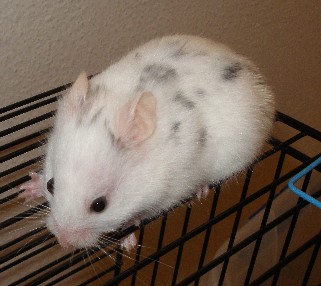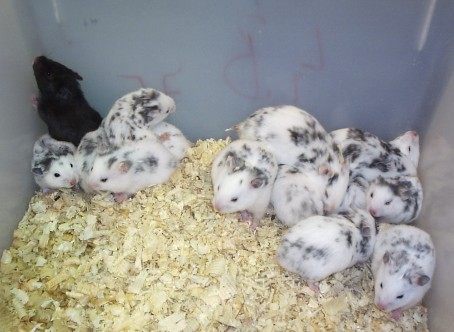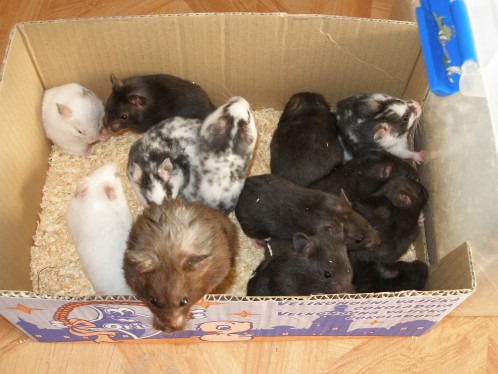 |
Syrian Hamster
Nom Spot Research
Description
 |
Nom spot actually seems to be a new pattern
of fur in Syrians. This pattern looks alike Dalmatian dogs. The first crossings
show probability of Dominant Spot with some new modifier named provisionally
after agreement of members on HIF
nom spot. It seems that nom spot alone shows no changes in appearance maybe only
more white on bottom parts of body - neck, chest and belly. Eyes of nom spot
Dominant Spot are on the first sight black but if you look more attentively or
use light into eyes, you can see big red circle inside. The same you can see in
eyes of Dominant Spots with one nom spot gene.
|
|
 |
 |
 |
 |
History
 In October 2006 I saw on exhibition of small
rodents in Prague unusually patterned Syrian Hamster. Owner Líza Švejdová
told me that she bought him on bursa Živá
exotika in Prague at the beginning of October and that seller has many of
these. I asked Jan (The River Road Hamstery)
by e-mail to hear what she thinks about it, why it is so few spotted.
Jan after asking some breeders of Dominant Spots answered me that it could but
might not be something new and it is worth-folowing.
In October 2006 I saw on exhibition of small
rodents in Prague unusually patterned Syrian Hamster. Owner Líza Švejdová
told me that she bought him on bursa Živá
exotika in Prague at the beginning of October and that seller has many of
these. I asked Jan (The River Road Hamstery)
by e-mail to hear what she thinks about it, why it is so few spotted.
Jan after asking some breeders of Dominant Spots answered me that it could but
might not be something new and it is worth-folowing.
In November 2006 I went to bursa to meet
seller. I bought two hamsters also so few spotted and I saw he had many of
these. I sent story on HIF. Seller got his new name  Dalmatian man and he is
named so forever. After asking him about I learnt that he imported it from
Holland from some similar bursa, that he is crossing them together to get these
and he told me that he sometimes get also unpatterned ones. I saw some answers
about on HIF, and there was also opinion about being Dominant Spot White Bellied
DsdsWhwh, because of it I was scared to make crossing with two few spotted
animals together because from crossing DsdsWhwh x DsdsWhwh, which I had planed
could come anophtalmic white hamster WhWh. In the evening before next bursa in
December I was contacted by Janice (Holmden Hill Haven)
who I met on HIF, with asking me to buy for her some of these for export. During
the night we firmed up to do export to USA.
Dalmatian man and he is
named so forever. After asking him about I learnt that he imported it from
Holland from some similar bursa, that he is crossing them together to get these
and he told me that he sometimes get also unpatterned ones. I saw some answers
about on HIF, and there was also opinion about being Dominant Spot White Bellied
DsdsWhwh, because of it I was scared to make crossing with two few spotted
animals together because from crossing DsdsWhwh x DsdsWhwh, which I had planed
could come anophtalmic white hamster WhWh. In the evening before next bursa in
December I was contacted by Janice (Holmden Hill Haven)
who I met on HIF, with asking me to buy for her some of these for export. During
the night we firmed up to do export to USA.
In December 2006 I ran to bursa for 2 males for me and 6.6 for export with Janice. I asked Dalmatian Man, if he got some defect puppies or blind. He said no.
In January 2007 were 6.6 nom spot Dominant spots successfully exported to the USA.
 |
 |
In book Encyclopedia of rabbits and rodents from Esther Verhoef-Verhallen published in 1998 in Netherlands there is one photo of the same few spotted Syrian. Every feet goes to Holland for now.
However there are some more or less confirmed occurences of these hamsters in surrounding European countries - namely beyond talked Holland also in Germany, Denmark and Finland. And bought in Prague also in Slovakia and Hungary.
Genetics
Actually it seems that it is some new recessive gene or modifier seen in conjuction with Dominant Spot I will provisionally use these terms for naming results in offspring:
nom spot DS for few spotted animals
DS with one nom spot gene for hamsters who look like common Dominant Spots but who have red circle in their eyes
nom spot for hamster who looks like unpatterned but has more white on belly and under chin and has two nom spot parents, so I suppose that it has two nom spot genes
unpatterned with one nom spot gene for animal, who I suppose that carries one nom spot gene
unpatterned for animals without any nom spot genes
and DS for unrelated Dominant Spots without red circle in their eyes
 |
 |
 |
 |
 |
 |
 |
 |
 |
Breeding
It seems that the best way how to do nom spot Dominant Spots is mate two nom spot Dominant Spots together. The first lines are entirely Black coloured.
Experimental Proofs of Gene Character and Transmission
The research is on the beginning of proof.
From the Hamstery Od Lízy
 |
|
Used by permission of Líza Švejdová, b.s. Od Lízy, http://www.krecci.tarbik.com/ |
This male nom spot DS was mated to unpatterned female. From this crossing came out 9 puppies, 5 DS with one nom spot gene and 4 unpatterned with one nom spot gene. Litter A1 Od Lízy.
 |
 |
 |
|
Used by permission of Líza Švejdová, b.s. Od Lízy, http://www.krecci.tarbik.com/ |
||
From the Riky Hamstery
First crossing of two nom spot Dominant Spots showed that it could really be something new. There were born 7 puppies, 4 nom spot DS and 3 nom spots. Litter P1 Riky.
 |
 |
 |
Second mating nom spot DS male with Black Tortoiseshell female without nom spot genes gave this result: 12 puppies, 5 DS with one nom spot gene, 7 unpatterned with one nom spot gene. Litter R1 Riky.
 |
 |
 |
The third mating: nom spot DS male x Banded Yellow female. 9 puppies, 2 DS with one nom spot gene, 2 DS Banded with one nom spot gene, 2 DS Tort with one nom spot gene, 1 DS Tort Banded with one nom spot gene, 1 Tort Banded probably with one nom spot gene and 1 unpatterned with one nom spot gene. Litter A2 Riky.
 |
 |
 |
 |
 |
 |
The fourth mating: nom spot male to nom spot DS female. 4 babies, 3 nom spot DS and 1 nom spot. Litter B2 Riky.
 |
 |
 |
 |
 The
fifth mating: nom spot DS male to female DS with one nom spot gene. 7 babies,
1 nom spot DS, 2 DS with one nom spot gene, 3 nom spot and 1 unpatterned with
one nom spot gene. Litter E2
Riky.
The
fifth mating: nom spot DS male to female DS with one nom spot gene. 7 babies,
1 nom spot DS, 2 DS with one nom spot gene, 3 nom spot and 1 unpatterned with
one nom spot gene. Litter E2
Riky.
 |
 |
Next crossings furthering previous results: litter G2 Riky and litter H2 Riky.
From the Hamstery U Ferdy
|
|
|
|
| Used by permission of Líza Švejdová, b.s. Od Lízy, http://www.krecci.tarbik.com/ | ||
In the hamstery U Ferdy, there were used nom spot male and female DS with one nom spot gene. 7 babies, 2 nom spot DS, 2 DS with one nom spot gene, 3 nom spot or unpatterned with one nom spot gene. Litter A2 U Ferdy.
 |
 |
 |
 |
 |
 |
||
| Used by permission of Kristýna Kárová, b.s. U Ferdy, http://www.chs-ferda.wz.cz/ | |||